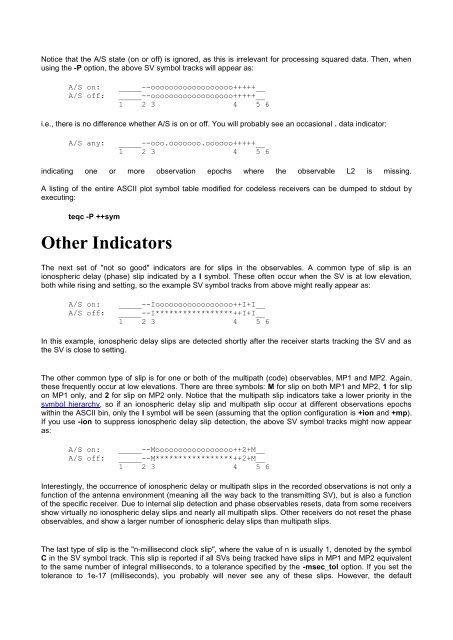Interpreting teqc's qc Mode Output Section 21. - Inpe
Interpreting teqc's qc Mode Output Section 21. - Inpe
Interpreting teqc's qc Mode Output Section 21. - Inpe
Create successful ePaper yourself
Turn your PDF publications into a flip-book with our unique Google optimized e-Paper software.
Notice that the A/S state (on or off) is ignored, as this is irrelevant for processing squared data. Then, whenusing the -P option, the above SV symbol tracks will appear as:A/S on:A/S off:_____--oooooooooooooooooo+++++_______--oooooooooooooooooo+++++__1 2 3 4 5 6i.e., there is no difference whether A/S is on or off. You will probably see an occasional . data indicator:A/S any:_____--ooo.ooooooo.oooooo+++++__1 2 3 4 5 6indicating one or more observation epochs where the observable L2 is missing.A listing of the entire ASCII plot symbol table modified for codeless receivers can be dumped to stdout byexecuting:te<strong>qc</strong> -P ++symOther IndicatorsThe next set of "not so good" indicators are for slips in the observables. A common type of slip is anionospheric delay (phase) slip indicated by a I symbol. These often occur when the SV is at low elevation,both while rising and setting, so the example SV symbol tracks from above might really appear as:A/S on:A/S off:_____--Iooooooooooooooooo++I+I_______--I*****************++I+I__1 2 3 4 5 6In this example, ionospheric delay slips are detected shortly after the receiver starts tracking the SV and asthe SV is close to setting.The other common type of slip is for one or both of the multipath (code) observables, MP1 and MP2. Again,these frequently occur at low elevations. There are three symbols: M for slip on both MP1 and MP2, 1 for slipon MP1 only, and 2 for slip on MP2 only. Notice that the multipath slip indicators take a lower priority in thesymbol hierarchy, so if an ionospheric delay slip and multipath slip occur at different observations epochswithin the ASCII bin, only the I symbol will be seen (assuming that the option configuration is +ion and +mp).If you use -ion to suppress ionospheric delay slip detection, the above SV symbol tracks might now appearas:A/S on:A/S off:_____--Mooooooooooooooooo++2+M_______--M*****************++2+M__1 2 3 4 5 6Interestingly, the occurrence of ionospheric delay or multipath slips in the recorded observations is not only afunction of the antenna environment (meaning all the way back to the transmitting SV), but is also a functionof the specific receiver. Due to internal slip detection and phase observables resets, data from some receiversshow virtually no ionospheric delay slips and nearly all multipath slips. Other receivers do not reset the phaseobservables, and show a larger number of ionospheric delay slips than multipath slips.The last type of slip is the "n-millisecond clock slip", where the value of n is usually 1, denoted by the symbolC in the SV symbol track. This slip is reported if all SVs being tracked have slips in MP1 and MP2 equivalentto the same number of integral milliseconds, to a tolerance specified by the -msec_tol option. If you set thetolerance to 1e-17 (milliseconds), you probably will never see any of these slips. However, the default
















